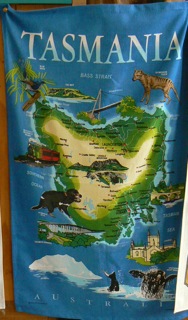 Distant and remote as Tasmania may be, 150 miles off the south coast of Australia, it still has a full story to tell about gay life, from a sad and tormented beginning to fulfilling and modern LGBT scene. There is much to tell about this picturesque state (Australia has six states and two terrtories).
Distant and remote as Tasmania may be, 150 miles off the south coast of Australia, it still has a full story to tell about gay life, from a sad and tormented beginning to fulfilling and modern LGBT scene. There is much to tell about this picturesque state (Australia has six states and two terrtories).
The story here is in eight parts, from past to present, each of which can be read separately. Part eight is about our hosts for some days in Huonville, Tasmania at the Huon Bush Retreat, an conscious and ecological place to savor the wonders of nature.
1 History
The history of Caucasian homosexuality in Tasmania can be said to have started in jail. This beautiful island of rain forests, rolling green hills, endless white beaches, azure blue waters, rocky coastlnes and dense eucalyptus forests was designated by the British as a good spot to rid England of criminals. In their malevolence the bewigged judges, starting during the reign of King George III (1760-1820), sentenced thousands of prisoners (162,000 from 1786 to 1868), hundreds at a time, to be exported (‘transported’) onto stinking crowded wooden galleons, for committed crimes, to the ‘fatal shores’ of Australia, including Tasmania known then as Van Diemen’s Land. One could receive a sentence of seven years exile for petty theft or forgery or politcal activism. (See book review of ‘The Fatal Shore’)
Nothing is known about same-sex attraction among the Aborigines who inhabited Tasmania for thousands of years before the arrival of white prisoners, military guards and settlers. As one Aboriginal gay athlete told me some years ago during the Gay Games in Sydney in 2002, “the white man came and destroyed our culture, our traditions and our history—including same-sexuality history. So we know nothing about it today.”
In 1810-12 a colony of convicts (indentured like slaves) built one of the largest 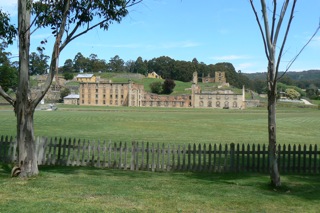 penitentiaries in the British empire near the present day capital of Hobart in Tasmania. Now in ruins as a popular tourist attraction (photo left), it was and is called Port Arthur, named after the Lt Governor of the island George Arthur who had the onerous task of housing, feeding and treating the unfortunates who arrived in his care (not to mention the genocidal task of ridding the island of native Aborgines).
penitentiaries in the British empire near the present day capital of Hobart in Tasmania. Now in ruins as a popular tourist attraction (photo left), it was and is called Port Arthur, named after the Lt Governor of the island George Arthur who had the onerous task of housing, feeding and treating the unfortunates who arrived in his care (not to mention the genocidal task of ridding the island of native Aborgines).
In the sprawling Port Arthur prison compound—a village within itself–men, women and children were thrown together at first in a massive jam of cells and stalls regardless of the crimes they has committed.
A boy of twelve (who had only stolen a loaf of bread) was put among aggressive adult felons. A girl of 14 (who had pilfered some wool) was forced among a gang of spiteful disheveled thieves. One can imagine the physical, sexual and verbal abuse these children received. Child abuse was rampant and it wasn’t until a couple of years later that Gov. Arthur recognized the excess of risk these young ones suffered and had all children under 18 moved to a separate jail built nearby on one of the small isla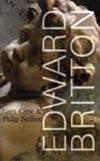 nds in the harbor, called Puer Island.
nds in the harbor, called Puer Island.
(For an inside view of life on Puer Island read the recent book titled Edward Britton by Gary Crew and Philip Neilsen that tells the story about two adolescent convicts, Edward Britton and Izod Wolfe, who are imprisoned there. Edward falls in love with the Commandant’s daughter while Izod is determined to seek revenge for his family death by killing the Commandant.)
Sodomy was punishable by hanging but it did little to stop the practice; people became more careful instead of remorseful.
On their island the children were given training in skills such as stone cutting, wood carving or weaving that in turn helped to house and clothe the penal colony. Today the skeleton of a finely-cut stone church (photo left) with an elegant steeple stands as testimony to the degree of skill these young people developed.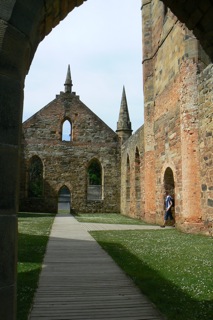
And on Puer Island one might well suggest, the degree of abuse was lessened although not eliminated. No doubt the older boys and girls preyed on the younger boys and girls despite attempts at close supervision. The punishment of being banished from England was perhaps the least part of the sentence these children suffered. Confined to limited quarters with common sleeping and sanitation facilities, survival and sexuality, after hunger, were never far from thought in the mix of inmates.
Even before the British parliament passed its draconian anti-gay laws that criminalized same-sex behavior, ‘buggery’ was considered against the laws of nature and condemned as a sin. But in 1885 with the passage of the laws darkness descended on homo-sex, be it love or lust; it became a crime that dared not speak its name.
Nevertheless, legal or not, moral or not, sinful or not, homosexual desire arrived with the first shiploads and remained present among all classes of settlers and among the prisoners of Port Arthur, adult or child. Many young men and women became experienced in the ways of the world, gay and straight, during their prison years.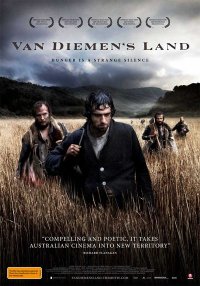
A recent 2009 film titled ‘Van Diemen’s Land’ (the former name for Tasmania) depicts the famous escape of eight convicts from Port Arthur into the dense wilderness. Aside from the horrors of survival (including cannibalism) the film also portrays, in an obvious yet subtle manner, the intimate bond between two of the men. (See film review) These were only two of many couples that formed tight affections during the eight decades of Port Arthur’s active existence.
Many ex-convicts, after their release from this and other penal colonies of Australia (there were several including Sydney), chose not to return to England with its grim life. With new skills learned in prison (legal and otherwise) they struck out to find useful employment, or further crimes. To be sure, more than a few of them continued primary relationships first discovered behind bars which led to the population growth of early Australia.
Port Arthur prison operated from 1810 to 1860 although other jails preceded and succeeded it on mainland Australia.
2 Late 19th early 20th Centuries
Skip to the late 19th and early 20th century where records reveal gay life continuing in various forms. While London’s Oscar Wilde’s was crushed by the anti-gay laws there (he died in Paris in 1900, a broken man), other gay people were far away in Tasmania and conducted their affairs in secret and not-so-secret. 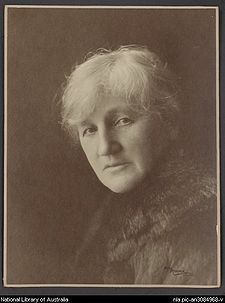
Such as the famous writer and painter Marie Bjelke-Petersen (photo right) who lived in a primary relationship with Sylvia Mills for thirty years after their meeting in 1898.
Meanwhile, Henry Winkelmann and Stanley Dowsett were both members of an expedition to observe the 1910 solar eclipse from Port Davey in Tasmania.
Winkelmann (photo below left) was a noted photographer and the two men were on display, in photos, in 2009, at the Victoria Museum in Launceston, Tasmania’s second largest city, where they were identified as a gay couple in one of the exhibition halls.
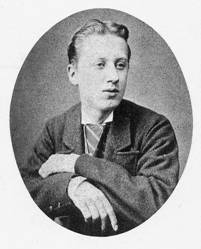 The description of one photo says: “Unusually for the time, Winkelmann was openly gay. It is probable that Dowsett was his partner at the time of the expedition, and a sign over their tent read ‘Abode of Love’”. The photo shows the two men, one sitting one standing, in front of their ‘abode’. (Photo right)
The description of one photo says: “Unusually for the time, Winkelmann was openly gay. It is probable that Dowsett was his partner at the time of the expedition, and a sign over their tent read ‘Abode of Love’”. The photo shows the two men, one sitting one standing, in front of their ‘abode’. (Photo right)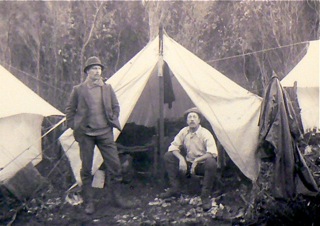
This small easily-overlooked exhibit is remarkable for two reasons: the present-day curator of the museum has chosen to reveal the sexual orientation of these men, something rarely seen in museums of any sort, presumably seeing it as an important aspect for a modern audience; and also to remind viewers that homosexuality is not a new ‘agenda’, that preceding generations were populated with gay people of notable repute and achievement.
3 Closer to Today
In 1983 the environmental leader Bob Brown campaigned successfully for a seat in the Australia parliament; he was openly gay in a time when homosexual behavior was illegal in Tasmania and punishment led to jail.
But by 1982, there were already changes in the wind as the Tasmanian Law Reform Commission recommended gay law reform and 1988 the Tasmanian Gay and Lesbian Rights Group (TGLRG) formed. A year later Labor and the Greens political parties were committed to gay law reform as a part of their Accord.
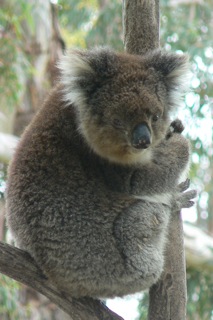 But it would take another eight years of contentious legal, political and social activism (involving the United Nations, local civil disobedience and the Australian high court) to finally persuade the ruling Liberal party in Tasmania to end its opposition to reform. An earlier boycott of Tasmanian produce had also weakened their intransigence.
But it would take another eight years of contentious legal, political and social activism (involving the United Nations, local civil disobedience and the Australian high court) to finally persuade the ruling Liberal party in Tasmania to end its opposition to reform. An earlier boycott of Tasmanian produce had also weakened their intransigence.
Finally in April 1997 the Premier announced his party’s revised vision for a socially inclusive Tasmania and said the Upper House now supported the principle of sexuality law reform. All too slowly, in May 1997, the reform passed without conditional amendments. The momentum was such that the reform not only rid the country of archaic and offensive and laws but it also set a new standard for the equal treatment of all citizens.
This led, in 2003 after more wrangling led by activist Rodney Croome, to official recognition of domestic partnerships that currently gives same-sex relationships equal status to heterosexual marriages under nearly all state laws, and covers areas such as property transfers and superannuation (pension benefits).
Improving on this status, starting in November 2009, Tasmanian couples were able to register their relationship during a ‘ceremony’. The Tasmanian Registry of Birth, Deaths and Marriages made a change in procedure in the state’s Deed of Relationships scheme to give same-sex couples — along with opposite-sex couples — the option to legally sign a decorative relationship certificate during a ceremony in the presence of a state official, as well as friends and family.
4 Today: TasPride in Hobart
We happened to be in Hobart for this year’s 2-week-long Tasmanian Gay Pride festival, TasPride, on the day of their closing event, a picnic in Parliament Oval park, which provided a glimpse into the queer life in this capital city.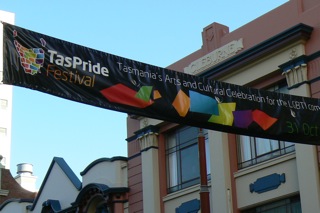
Instead of looking like the stereotypical LGBT festival with parades, banners, gyrating boys in shorts, political rallies and rock performers, gay Tassie was a folksy picnic with hot dogs, turkey sausages and lentil burgers. (photo below left)
Along with the popular handbag-throwing contest there was a gunny-sack race, a three-legged race (won by a lesbian with her 12-year-old son), a drag race (yes, a race to get ‘dressed’) a dog-trick competition (won by another lesbian whose 3-year-old son performed the dog tricks on behalf of their disobedient pet).
Standing around observing these feats of mastery were several dozen LGBT locals, out-of-towners and curious neighbors drinking coffee or soda or milk (and beer?). Among them was a retired transvestite who has lived that style for years even when he/she was a tugboat pilot in Hobart harbor.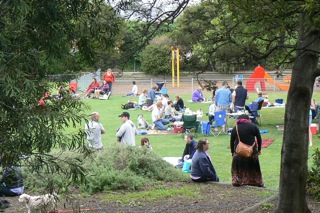
Chatting with the locals was easy. Hobart’s gay community is low-key, unpretentious, neighborly and conservative. There is no strident burning issue that has to be overcome—other than the gay marriage issue which is churning in Sydney and Canberra but is too much of a jump for the ‘provincial’ gay crowd in Tasmania.
One man told me that before legalization it was trendy for straight people to go to gay clubs in Hobart–there were three–because it was ‘edgy’ and an act of defiance. But when the new legitimacy happened there was no more thrill and two of the three venues eventually closed. The last one standing is Flamingos, a dance club in central city. (photo right)
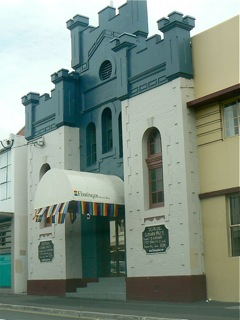 There are many gay folks who are not predatory and not actively seeking a primary mate or even a one-night-stand. I met several people who were too busy living their lives and pursuing interests and jobs to spend time hunting for the right mate.
There are many gay folks who are not predatory and not actively seeking a primary mate or even a one-night-stand. I met several people who were too busy living their lives and pursuing interests and jobs to spend time hunting for the right mate.
Jason is a teacher in Launceston city who lives a generally calm life with a cadre of friends, gay and straight with whom he shares some evenings out. He does not have a strong need to affiliate with the ‘gay scene’ and is content with his work, his house and his copious flower gardens so common around Tasmania.
Sue is an architectural ‘draftsman’ in Hobart who is available but makes little effort to become coupled. She currently is reading three books simultaneously, bikes along wilderness trails just outside the city and practices her cello with a small amateur group every Friday. “Besides,” she added, “this place is so small I know everyone who is not involved so there’s almost no point… I think if it’s meant to happen it will.”
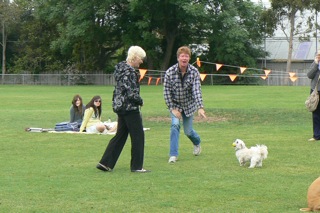 Her attitude is not uncommon from what I could tell. There is a resigned satisfaction with gay life here in Tasmania; there is no hard edge to gay life, no trend to keep up with, no fashion to follow. There are also many long-term LGBT couples (there were at least three long-term lesbian couples present at the picnic: photo left) who are enmeshed in large and small communities around the island living stress free lives—as far as gay issues are concerned.
Her attitude is not uncommon from what I could tell. There is a resigned satisfaction with gay life here in Tasmania; there is no hard edge to gay life, no trend to keep up with, no fashion to follow. There are also many long-term LGBT couples (there were at least three long-term lesbian couples present at the picnic: photo left) who are enmeshed in large and small communities around the island living stress free lives—as far as gay issues are concerned.
After the picnic, that evening, there was a final dance party of the festival—unless one chose to extend it, Tassie style, by going for a big bushwalk in the hills the next day.
5 Across Tasmania
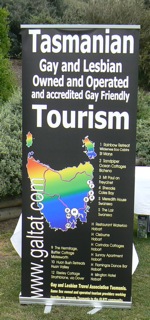 Tasmania may be small (26,500 sq mi, about the size of Lithuania or the American state of West Virgina) may be tiny compared to the whole of Australia (2,941,000 sq mi) but it does not lack LGBT functions or organizations.
Tasmania may be small (26,500 sq mi, about the size of Lithuania or the American state of West Virgina) may be tiny compared to the whole of Australia (2,941,000 sq mi) but it does not lack LGBT functions or organizations.
Across the state there are several dozen organizations that offer contact and support for LGBT needs, from coming out, to older companions, to health information to dancing to gay rights, there is a modest wealth of affiliations for anyone seeking them.
For visitors, the state tourist office offers a targeted brochure for travel offices and agencies as part of the Visit Tasmania campaign. Titled ‘Your Gay and Lesbian Visitor’s Guide’ it offers 30 pages of useful LGBT information such as translations of colloquialisms: ‘I’m feeling a bit queer’ means ‘I’m not feeling well’, and offers a history of gay life from its prison origins to present day pride. (See additional LGBT news)
‘Fresh Cafe on Charles’ owner Andrea has the most pro-gay place in Tasmania’s second city, Launceston. Here numerous LGBT friends and customers come for breakfast (only), coffee and conversation who live around town in a quiet conservative lifestyle. There is no full time LGBT venue in town although there is a weekly Friday gay night at ‘The Beat’.
That’s about the social gay scene in Launceston. So where can one find new friends and new dates in town? Most likely by driving to Hobart or, like the rest of the world, online to chat or arrange a meeting.
6 Coming Out
At Fresh, a free booklet, published in Tasmania, was available for young gays (guys mostly) called Man2Man with advice and commentaries about health and coming/being out. It also offers a website and an e-mail address for further information.
In a recent (quarterly) issue therapist Susie Dewes wrote about the issues surrounding the drug Ecstacy: “…remember, if you use E with a groups of friends have one person stay clean in case things go wrong.”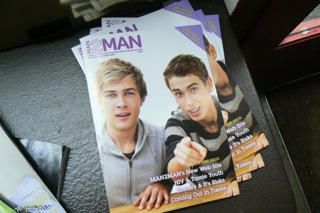
Another article is an interview with 22-year-old Ben who is out and living well. He encouraged gay teens not to be ashamed: “Why feel bad abut your self because you were born gay. It’s not as if you made a choice to be gay.”
This is followed by a listing of over 60 LGBT organizations in Tasmania and a dozen websites for contact or help for gay youth. And on the back cover there are listings for gay events such as the annual TasPride festival.
7 HIV
The most outstanding concern in Man2Man is the recent up-tic in HIV infection rates among younger gay men. This is also a phenomenon being seen around major western urban centers such as Sydney as gen-y grows up fearless knowing there are powerful anti-retroviral drugs that stall the disease in case of infection.
To address the problem in Tasmania, a public health education program is aimed at young people, offering brochures and clinic information as well as reports in the media. The Men2Men brochure in Launceston also carries descriptive and direct advice on sexual safety. “For the first time in many years there has been a significant rise in the numbers of newly acquired HIV in young Tasmanian guys under the age of 25. Prior to 2008 most cases of HIV affected guys in their late 30’s to 40’s so this recent change is of concern.”
The campaign presses hard to educate newly gay kids and remind older gay men that people still get very sick and die of HIV and that medications are harsh on the entire body—and there is still stigma and discrimination against HIV patients.
8 Hideouts in the Bush
Spread out across Tasmania, which is nearly 80% wilderness, are many LGBT individuals and couples, organizations and businesses, mostly in the Hobart and Launceston areas, who collectively form an active LGBT network, including a weekly radio program.
Among these are several gay-owned cafes and accommodations including two ‘bush retreats’, eco lodges in wilderness settings. Rainbow Retreat and Huon Bush Retreat are similar ‘environmentally light’ guest lodgings with solar power, fresh ground water, wood-burning fireplaces and very small carbon footprints. Rainbow has sweeping views of the sea while Huon is nestled in dense forest.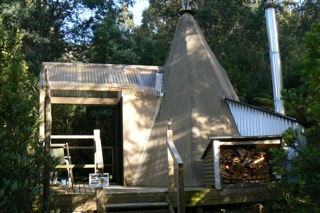
We stayed at Huon for two nights and were treated to the sounds of exotic wild birds and visits from wallabys and possums. Hosts/owners Paul Dimmick and Michael Higgins opened the retreat six years ago by buying up land that was threatened by logging companies.
With financial backing from silent partners they have continued to increase the property and dedicate it as a nature reserve thus preventing—forever—any development or destruction.
The issue of being a gay couple has hardly ever come up in their many dealings with banks, lawyers, estate agents or local merchants. Talking in the open-air ‘kitchen’ of the retreat Paul said there has never been a problem about sexuality—other than the gay guy who checked in then asked if he could walk around the trails naked. “There are no ‘gay ghettos’ like you find in larger cities — everyone just lives side by side.”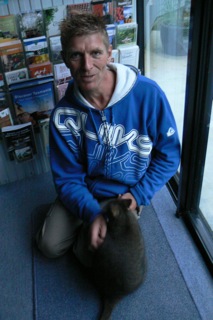
Paul was pleased to be gay and proud of the fact that their retreat is carbon positive by 3890 tons of CO2 a year, creating carbon offset credits that can be sold to eco-friendly Bendigo Bank for cash to buy even more land. (Photo right, Paul with pet wallaby)
Finally
Gay life in Tasmania may be a bit isolated from the big city lights and steam, but hardly anyone here complains since they know their state is a slice of paradise.
Also see:
Gay Australia News & Reports 2000 to present
Gay Australia Photo Galleries
















